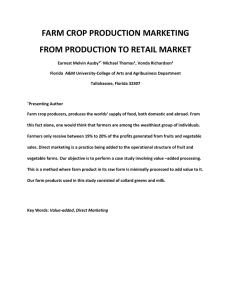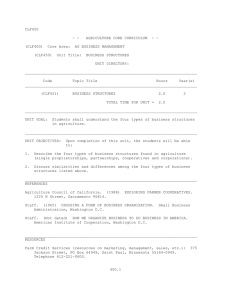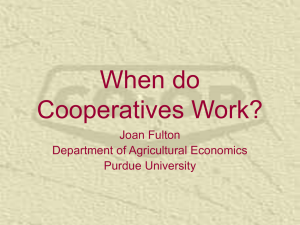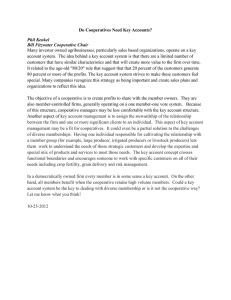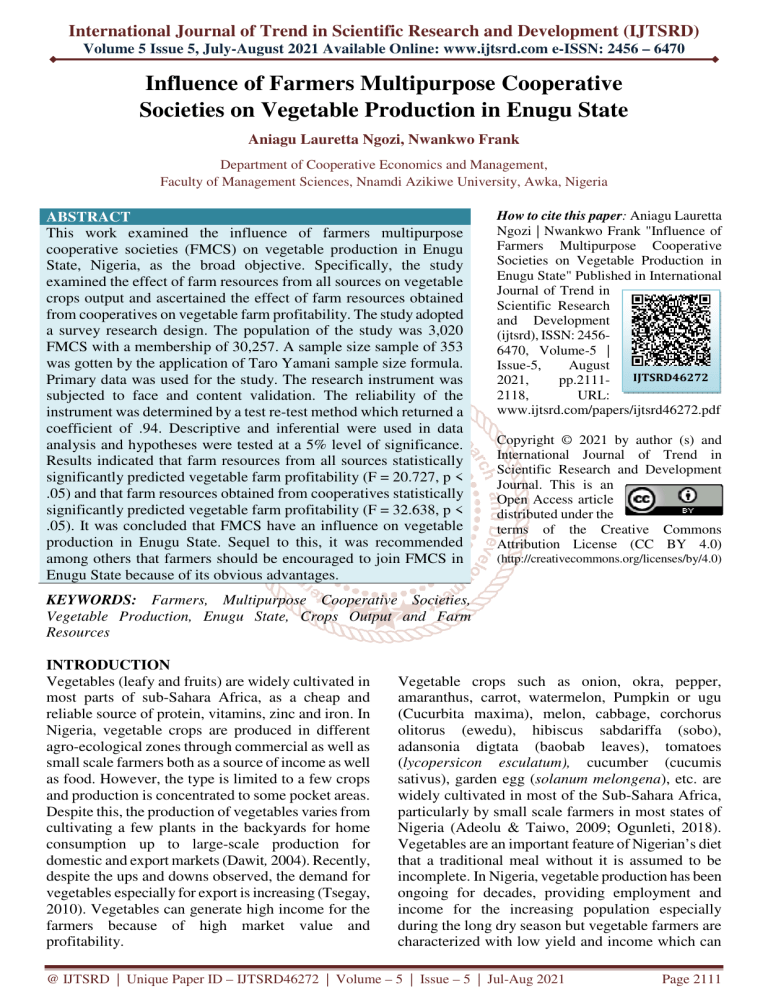
International Journal of Trend in Scientific Research and Development (IJTSRD)
Volume 5 Issue 5, July-August 2021 Available Online: www.ijtsrd.com e-ISSN: 2456 – 6470
Influence of Farmers Multipurpose Cooperative
Societies on Vegetable Production in Enugu State
Aniagu Lauretta Ngozi, Nwankwo Frank
Department of Cooperative Economics and Management,
Faculty of Management Sciences, Nnamdi Azikiwe University, Awka, Nigeria
ABSTRACT
This work examined the influence of farmers multipurpose
cooperative societies (FMCS) on vegetable production in Enugu
State, Nigeria, as the broad objective. Specifically, the study
examined the effect of farm resources from all sources on vegetable
crops output and ascertained the effect of farm resources obtained
from cooperatives on vegetable farm profitability. The study adopted
a survey research design. The population of the study was 3,020
FMCS with a membership of 30,257. A sample size sample of 353
was gotten by the application of Taro Yamani sample size formula.
Primary data was used for the study. The research instrument was
subjected to face and content validation. The reliability of the
instrument was determined by a test re-test method which returned a
coefficient of .94. Descriptive and inferential were used in data
analysis and hypotheses were tested at a 5% level of significance.
Results indicated that farm resources from all sources statistically
significantly predicted vegetable farm profitability (F = 20.727, p <
.05) and that farm resources obtained from cooperatives statistically
significantly predicted vegetable farm profitability (F = 32.638, p <
.05). It was concluded that FMCS have an influence on vegetable
production in Enugu State. Sequel to this, it was recommended
among others that farmers should be encouraged to join FMCS in
Enugu State because of its obvious advantages.
How to cite this paper: Aniagu Lauretta
Ngozi | Nwankwo Frank "Influence of
Farmers Multipurpose Cooperative
Societies on Vegetable Production in
Enugu State" Published in International
Journal of Trend in
Scientific Research
and Development
(ijtsrd), ISSN: 24566470, Volume-5 |
Issue-5,
August
IJTSRD46272
2021,
pp.21112118,
URL:
www.ijtsrd.com/papers/ijtsrd46272.pdf
Copyright © 2021 by author (s) and
International Journal of Trend in
Scientific Research and Development
Journal. This is an
Open Access article
distributed under the
terms of the Creative Commons
Attribution License (CC BY 4.0)
(http://creativecommons.org/licenses/by/4.0)
KEYWORDS: Farmers, Multipurpose Cooperative Societies,
Vegetable Production, Enugu State, Crops Output and Farm
Resources
INTRODUCTION
Vegetables (leafy and fruits) are widely cultivated in
most parts of sub-Sahara Africa, as a cheap and
reliable source of protein, vitamins, zinc and iron. In
Nigeria, vegetable crops are produced in different
agro-ecological zones through commercial as well as
small scale farmers both as a source of income as well
as food. However, the type is limited to a few crops
and production is concentrated to some pocket areas.
Despite this, the production of vegetables varies from
cultivating a few plants in the backyards for home
consumption up to large-scale production for
domestic and export markets (Dawit, 2004). Recently,
despite the ups and downs observed, the demand for
vegetables especially for export is increasing (Tsegay,
2010). Vegetables can generate high income for the
farmers because of high market value and
profitability.
Vegetable crops such as onion, okra, pepper,
amaranthus, carrot, watermelon, Pumpkin or ugu
(Cucurbita maxima), melon, cabbage, corchorus
olitorus (ewedu), hibiscus sabdariffa (sobo),
adansonia digtata (baobab leaves), tomatoes
(lycopersicon esculatum), cucumber (cucumis
sativus), garden egg (solanum melongena), etc. are
widely cultivated in most of the Sub-Sahara Africa,
particularly by small scale farmers in most states of
Nigeria (Adeolu & Taiwo, 2009; Ogunleti, 2018).
Vegetables are an important feature of Nigerian’s diet
that a traditional meal without it is assumed to be
incomplete. In Nigeria, vegetable production has been
ongoing for decades, providing employment and
income for the increasing population especially
during the long dry season but vegetable farmers are
characterized with low yield and income which can
@ IJTSRD | Unique Paper ID – IJTSRD46272 | Volume – 5 | Issue – 5 | Jul-Aug 2021
Page 2111
International Journal of Trend in Scientific Research and Development @ www.ijtsrd.com eISSN: 2456-6470
be solved by Farmers’ Multipurpose Cooperative
Societies (FMCS).
The purpose of FMCS is to help farmers increase
their yields and income by pooling their resources to
support collective service; provisions and economic
empowerment. Farmers’ cooperatives are seen as
critical to achieving the government’s developmental
targets in the Growth and Transformation Plan, and
focusing on other types of cooperatives requires an
alternative framework for analysis. The main
categories of farmers’ cooperatives fall into
mainstream activities of the agricultural undertaking
including supply of agricultural inputs, joint
production and agricultural marketing. Input supply
includes the distribution of seeds and fertilizers to
farmers.
Government has always emphasized the development
and promotion of cooperatives to facilitate
agricultural activities, for instance in Nigeria,
government established two cooperative development
agencies; Nigerian Agricultural Cooperative and
Rural Development Bank (NACRDB) Ltd and the
Nigerian Agricultural Cooperative Marketing
Organization (NACMO), to accelerate cooperative
development in Nigeria (Agbo, 2010). Cooperative
societies provide training and seminars for members
as well as credit facilities (Agbo, 2010). These are
among the measures that define the performance of
cooperative societies as they have the possibility to
influence vegetable production. It is against this
background that the researcher decided to research
the influence of farmers multipurpose cooperative
societies on vegetable production in Enugu State as
the broad objective. The specific objectives of the
study are to:
1. Examine the effect of farm resources from all
sources on vegetable crops output.
2. Ascertain the effect of the farm resources
obtained from cooperatives on vegetable farm
profitability.
REVIEW OF RELATED LITERATURE
Concept of Vegetable
The term vegetable is used to describe the tender
edible shoot, leaves, fruits and roots of plants and
spices that are consumed whole or in part, raw or
cooked as a supplement to starchy foods and meat
(Olasantan, Makinde & Salau, 2018). Agwu (2011)
define vegetable as the edible portion of a plant
(excluding fruits and seeds), such as the roots, tubers,
stems and leaves, a common definition that excludes
sugar crops such as sugarcane and sugar beet as well
as starchy root crops such as cassava, yams, and taro.
people of different tribes and ethnicities, whose major
common denominator is the use of vegetables in
preparing their food, vegetable farming in Nigeria is
indeed a reliable business, especially in the off-season
when other crops could not be commercially
produced and could generate a higher amount of cash
income per unit area of land more than other crops
and ensure continuous in-flow of cash to farmers
which makes it very profitable (Ogunleti, 2018).
The common vegetables cultivated in the Eastern part
and Enugu State, in particular, are Okro
(Abelmoschus esculentus), Water Leave (Talinum
triangulare), Pepper (Piper nigrum), Scent Leave
(Ocimum grattissimum), Green (Omocestus
viridulus), Tomatoes (Lycopersicon esculatum),
Cucumber (Cucumis sativus), Garden egg (Solanum
melongena), Curry (Murray akoenigii), Bitter Leave
(Vernonia amygdalina) (Osuji, Ehirim, Rahji,
Awoyemi, Salman, Odii, Onyemuwa, Ibeagwa,
Chikezie and Okwara, 2017).
Among the rural dwellers in Nigeria, especially in the
southern part, green vegetables such as amaranthus,
basil, bitter leaf and fruited pumpkin are cultivated at
the backyard gardens or farms close to their living
houses on small scale. It seems that small scale
farming is the genesis of agricultural and communal
life; and is known to contribute to food security
(Emodi & Albert, 2018). Backyard farming on small
plots of land has been in existence from the time of
communal settlement among the cavemen (Dilrukshi,
Russell & Karim, 2013). Vegetable production,
though practised as backyard farming by some
farmers, is faced with fairly large capital and
considerable investment on lands, soil amendments
and watering equipment (Osuji et al, 2017).
Cultivating vegetables close to the house is intended
for ease, convenience and accessibility while cooking,
and getting it fresh straight to the pot. Backyard
gardens could be seen as ways to relieve hunger and
its concerns in the face of a food crisis. These
vegetables are harvested and collected fresh from the
farm to the pot at will, without specified harvesting
season. It was noted that most households consume
the majority of their produce, though they sell some
that are produced in excess (Mgbada, Adesope, and
Enyinda, 2014). These proceeds are partly used to
purchase other foods that are needed by the family
members which are not cultivated in their homestead
farm. The cultivated vegetables are waste from
previously bought and used seed or stalks from the
market. Through this, environmental wastes can be
reduced and climate change and biodegradation
would be cut to a minimal (Emodi and Albert, 2018).
Vegetable farming is one of the silent money makers
in Nigeria. In a country made up of over 100 million
@ IJTSRD | Unique Paper ID – IJTSRD46272 | Volume – 5 | Issue – 5 | Jul-Aug 2021
Page 2112
International Journal of Trend in Scientific Research and Development @ www.ijtsrd.com eISSN: 2456-6470
A vegetable is used in preparing Egusi, Afang,
Ogbono, Edikang Ikong, and many other Nigerian
delicacies (Ogunleti, 2018), and it plays important
role in bodybuilding due to its nutritional value,
economic security and its short maturity cycle. The
aim of eating fresh vegetables is for the nutritional
content and therefore it requires being consumed
fresh for body nourishment. According to Dimelu and
Odo (2013), vegetable composition is imperative in
human nutrition, because it contains vital nutrients
such as vitamins C (ascorbic acid), A, thiamine (B1),
pyridoxine (B6), niacin (B3),
folacin (B9), E, minerals, and dietary fibre.
Vegetables are rich sources of vitamins A, B, and C
which helps to lower susceptibility to infection. e.g.:
Carrots, sweet corn, amaranthus and celosia provide
Vitamin A; Bitter leaf, waterleaf, solanum and celosia
provide Vitamin B; Tomatoes, carrots, lettuce,
cabbage and amaranthus provide Vitamin C
(Olasantan et al, 2018).
Adequate consumption could reduce human diseases,
such as gastrointestinal cancer deaths, cardiac disease
and stroke deaths worldwide (Dimelu and Odo,
2013). In support, American Heart Association (2013)
reported that fruit and vegetables are estimated to
reduce cancers of the digestive system to about 19%,
heart disease to 31% and stroke to 11%.
Vegetables were said to be rich in vitamins and
minerals substances such as antioxidants and betacarotene which are assumed to protect the body
against damaging chemicals. Vegetable consumption
seems high in demand, and vegetable farming is
becoming a lucrative business in developing countries
such as Nigeria. It seemed difficult for farmers to
meet up with the high demand for vegetables because
of the poor road network, poor transportation, timing;
poor packaging and branding of vegetables (Tavonga,
2014). On the occasion that vehicles break down on
the road, vegetables for their perishable nature would
weaken with time spent in transportation, and most
times might get rotten before they reach the market
and the consumers. Vegetable’s nutritional content
when it fails to reach the consumers on time depletes
because the consumers will not receive it fresh for
consumption.
organization where different entrepreneurs of
cooperators pool their resources together with the
view of making a surplus. Lawal (2002), sees this
organization as an industrial organization where
several people may combine as consumers to produce
a commodity, the proceeds of which are distributed
among the participants. Brown (2006), thinks of a
cooperative society as a business organization in
which a group of individuals who have a common
interest, mutually agree to join together to establish
this business in order to promote their economic
activities like production, distribution or marketing of
goods and services, and for the provision of welfare
benefits to their members.
The International Cooperative Alliance (ICA, 2010)
defines a cooperative as "an autonomous association
of persons united voluntarily to meet their common
economic, social and cultural needs and aspirations
through a jointly-owned and democraticallycontrolled enterprise". It is a business voluntarily
owned and controlled by its member patrons and
operates for them and by them on a non-profit basis.
It is also a business enterprise that aims at the
complete identity of the component factors of
ownership control and use of services (Nweze, 2001).
The multipurpose type of cooperative societies is
gaining wide popularity among Nigerians because of
a number of benefits which include reduced
administrative costs, diversification of interests and
services, economies of scale and linkage of economic
activities (Agbo, 2010).
This study focuses on cucumber, garden egg melon
ugu and tomatoes because they are adopted crops in
Enugu State.
Arua (2004) viewed cooperatives as an important tool
for improving the living conditions of farmers.
According to Bhuyan (2007) cooperatives are
especially seen as significant tools for the creation of
jobs and the mobilization of resources for income
generation. Levi (2005) asserted that cooperatives
employed more than 100 million men and women
worldwide. In Nigeria, cooperatives provide locally
needed services, employment and input to farmers,
cooperatives also provide opportunities to farmers to
organize themselves into groups to provide services
that will facilitate the output of members. According
to Nweze (2002) cooperative societies serve as
avenues for input distribution. Through their
nationwide structure, they have developed strong and
reliable arrangements for the distribution of food
crops, fertilizers, agrochemicals, credits, seeds, and
seedlings.
Cooperative
A cooperative society is seen from different
perspectives by various scholars, writers,
policymakers and operators. Some of these writers are
of the view that the cooperative is a strong
Farmers’ Multipurpose Cooperative Societies and
Agricultural Production
Farmers multipurpose co-operatives play a very
important role both in establishing economic
structures and in motivating farmers to become more
@ IJTSRD | Unique Paper ID – IJTSRD46272 | Volume – 5 | Issue – 5 | Jul-Aug 2021
Page 2113
International Journal of Trend in Scientific Research and Development @ www.ijtsrd.com eISSN: 2456-6470
efficient and utilize improved techniques. This
greatest asset is great mobilization power. Farmers
cooperatives appeal to the self-interest of the farmer
in a way they can understand, can demonstrate things
with terrible results, make maximum use of the
locally available resources and prove that farmers
working together in a spirit of mutual aid can improve
their food production, production and economic
position.
There is sound evidence that farmers’ cooperatives
are an invaluable institution for promoting social and
economic development and achieving a more
equitable distribution of income. The aim and role of
farmers’ cooperatives vary widely to provide useful
services where none exists to reduce excessive cost of
middlemen, help farmers get a fair share of the
national income, direct agriculture towards the goal of
national economic planning and generally to improve
the social and economic conditions of the rural
people. Farmers usually regard and judge cooperatives in terms of economic benefit to members.
The role of cooperatives in food production is an
important topic of study and much has been done by
scholars and cooperators to justify its prime role in
securing economic and political development in the
country.
Cooperative societies have been known to make a
significant contribution to the economy, society and
cultural transformation of their economies and in
particular, agricultural transformation (Omoregbee
and Okoedo- Okojie, 2012). Ikpefan (2004)
highlighted the report of the International Labour
Organization (ILO) 89th Session, June (2001) on the
contributions of cooperatives to economic growth. In
that report, it was stated that the livelihood of nearly 3
billion people or half of the world's population was
made secure by cooperative enterprises based on the
United Nations estimates of 1994. Also, it was
reported that agricultural cooperatives are the largest
producers of fruits and vegetables for the national
market in Burkina Faso, responsible for 77% of
Cotton production in Cote d' lvoire and 90% of
national milk production and export 70 % of the
surplus wheat production in Uruguay (Omoregbee
and Okoedo-Okojie, 2012).
Performance of Multi-Purpose Cooperatives
Multi-purpose cooperatives are a unique type of
private enterprise that embraces both the associative
component as well as the business component and are
guided by the International Cooperative Alliance
(ICA) values and principles of cooperation. The
motive is inducing individuals to join existing or to
form new cooperatives that can originate in the
economic-rational sphere and the sociological and
psychological spheres. Multi-purpose cooperatives
are associations of primary producers who have come
together to achieve some common commercial
objectives more successfully than they could as
individuals such as marketing their produce,
purchasing farm supplies, purchasing consumer goods
for sale, sharing equipment, or supplying services
such as storage or transport. More generally, their
goal is to enable rural people to improve their social
and economic conditions by working together in ways
that are more productive than working individually
(Masuku et al, 2016).
Develtere et al. (2008) reported that the declining
performance of agricultural cooperatives has seen the
income of crop farmers dwindle over the years, a
situation that has triggered some of the co-operators
to come up with innovative cooperative ventures in
this sector. Furthermore, cooperatives are also
increasingly venturing into other non-traditional
sectors including housing, consumer, livestock and
bee-keeping. It is also significant to note that
cooperatives are increasingly looking beyond their
national borders to find markets for their products,
which was not possible in the era of state-controlled
cooperative development. Available information
suggests that such opportunities are increasingly
being utilized by cooperatives to tap economies of
scale to improve the productivity of their members.
Such cooperatives are operating as demand-driven
and market-oriented business organisations. The
result is the increasing improved performance of such
cooperatives as evidenced by higher turnover of the
cooperatives; improved income to the participating
members; and improved cooperatives.
Reports regarding the financial difficulties
experienced by agricultural cooperatives in Africa
have been much more common recently than news of
their successes. Several financial ratios for
cooperatives (revenue growth, return on assets and
operating margins) were calculated which indicated
weak performance in the cooperative sector. This
creates doubt about the viability of the cooperative
form of agriculture business, causing members to
question their cooperative's performance and/or
become reluctant to proceed in organizing a future
venture under the cooperative structure (Gray and
Kraenzle, 2002).
Factors that Affect Performance of Farmers
Cooperative Society
Cooperatives society in Nigeria has suffered several
setbacks, some of the responsible factors can be
traced back to the policy of the colonial masters who
introduced cooperative as a means to ensure that
farmers produced export crops (Attah, 2012). This led
@ IJTSRD | Unique Paper ID – IJTSRD46272 | Volume – 5 | Issue – 5 | Jul-Aug 2021
Page 2114
International Journal of Trend in Scientific Research and Development @ www.ijtsrd.com eISSN: 2456-6470
to misperception of the true meaning of cooperative
by the rural farmers in Nigeria. According to Eze
(2000), the majority of the vegetable farmers
cooperative members remain in the societies to gain
benefit from government agricultural assistance. He
also added that members were not willing to commit
their limited resources to the cooperative movement
and, therefore, resort to their status quo.
Agbo (2000) observed that the absence of clearly
stated government policies on channelling aids to
rural farmer cooperatives is a problem. There are
cases where government loan schemes to rural
farmers cooperatives pass through the ministry of
commerce and industry. Ministry of Agriculture or
even the ministry of local government and Rural
Development. This lack of a clearly established
channel for aids to Nigerian rural farmers has often
led to unhealthy and damaging competition between
the ministries concerned. This is not in the best
interest of the growth of agricultural cooperatives in
Nigeria.
Other factors that lead to the malfunction of the
farmers cooperative in respect to vegetable
production include the cooperative reliance on the
government for agric incentives, poor education
among the members (MAM SER 2000).
Nevertheless, Excessive bureaucracy has contributed
a lot to the problems of farmers cooperatives.
Government officials who handle agricultural
cooperatives matters tend to forget that farmers are in
entirely different types of business. This is because
agricultural activities must be performed, at definite
seasons and delays can be dangerous. Fund for preseason loans which are received late constitute a
problem to farmers rather than help (Martin, 2002).
METHODOLOGY
The research method adopted for this study was
survey method. The study was carried out in Enugu
State, Nigeria. The population of the study is
comprised of 3,020 FMCS with a membership of
30,257 all the members of the FMCS constitute the
population of this study with a sample size of 353,
arrived at using Yaro Yamani sample size formula.
Primary data (interview and questionnaire) was used
for the study. The research instrument was subjected
to face and content validation. The reliability of the
instrument was determined by a test re-test method
which returned a coefficient of .94. Descriptive
(mean) and inferential statistics (multiple linear
regression analysis) were used in data analysis, while
hypotheses were tested at a 5% level of significance.
PRESENTATION AND ANALYSIS OF DATA
The Effects of Farm Resources from All Sources on Vegetable Crops Output
Table 1:Mean Score of the Effects of Farm Resources from All Sources on Vegetable Crops Output
S/N
Items
SA
A
D
SD
Undecided Mean Remark
Quality seedlings and
102
276
17
14 chemicals are through the
4.17 Accepted
(26%) (70%)
(4)
private arrangement.
223
53
51
Credit needs are satisfied by
68
15
3.78 Accepted
other sources.
(17%) (57%) (13%) (13%)
122
136
68
Repayments are well spaced
69
16
3.48 Accepted
and in convenient instalments. (18%) (31%) (34%) (17%)
The number of government
51
156
188
17. extension officers visiting is
2.65 Rejected
(13%) (39%) (48%)
adequate.
Farm extension service from
119
105
102
69
18. other sources has boosted my
3.69 Accepted
(30%) (27%) (26%) (17%)
farm profitability.
Labour is provided through the
171
122
51
51
19
4.05 Accepted
private arrangement.
(43%) (31%) (13%) (13%)
Fertilizer needed is sourced
239
105
51
20.
4.48 Accepted
from the market.
(60%) (27%) (13%)
Grand mean
3.76 Accepted
Source: Field Survey, 2020
Table 1 shows the mean score of the effects of farm resources from all sources of vegetable output. Out of the 7
items, 6 items (14, 15, 16, 18, 19 and 20) were regarded as accepted because their respective mean ratings are
above the criterion mean of 3.00 which is the point for acceptance of the item in the questionnaire. Only one
item (17) was regarded as rejected because the mean rating was below the accepted mean rating. Furthermore,
@ IJTSRD | Unique Paper ID – IJTSRD46272 | Volume – 5 | Issue – 5 | Jul-Aug 2021
Page 2115
International Journal of Trend in Scientific Research and Development @ www.ijtsrd.com eISSN: 2456-6470
the grand mean ratings of the 7 items were 3.76 which was above the criterion mean of 3.00. This implies that
farm resources from all sources affect vegetable crops output.
The Effects of the Farm Resources obtained from Cooperatives on Vegetable Farm Profitability
Table 2: Mean Score of the Effects of the Farm Resources obtained from Cooperatives on Vegetable
Farm Profitability
S/N
Items
SA
A
D
SD
Undecided Mean Remark
Improved seedlings and
154
88
102
51
21 chemicals supplied are
3.87 Accepted
(39%) (22%) (26%) (13%)
obtained from cooperatives.
Much credit needed is satisfied
153
105
69
68
22
3.87 Accepted
by cooperatives.
(39%) (27%) (17%) (17%)
Repayments are well spaced
85
190
52
68
23
3.74 Accepted
and in convenient instalments. (21%) (48%) (13%) (17%)
Cooperative provides adequate
225
102
68
24
3.40 Accepted
extension officers.
(57%) (26%) (17%)
Farm extension service from
34
225
51
85
25 cooperative has boosted my
3.53 Accepted
(9%) (57%) (13%) (21%)
farm profitability.
Labour is provided through the
35
51
104
205
26
2.79 Rejected
cooperative arrangement.
(9%) (13%) (26%) (52%)
Fertilizer needed is sourced
35
138
119
103
27
3.27 Accepted
from cooperative.
(9%) (35%) (30%) (26%)
Grand mean
3.26 Accepted
Source: Field Survey, 2020
Table 2 shows the mean score of the effects of farm resources obtained from cooperatives on vegetable farm
profitability. Out of the 7 items, 6 items (21, 22, 23, 24, 25 and 27) were regarded as accepted because their
respective mean ratings are above the criterion mean of 3.00 which is the point for acceptance of the item in the
questionnaire. Only one item (26) was regarded as rejected because the mean rating was below the accepted
mean rating. Furthermore, the grand mean ratings of the 7 items were 3.26 which was above the criterion mean
of 3.00. This implies that farm resources obtained from cooperatives affect vegetable farm profitability.
Test of Hypotheses
H01: Farm resources from all sources have no significant effect on vegetable crops output.
Model
R
1
.529a
Table 3: Model Summaryb
R Square Adjusted R Square Std. Error of the Estimate Durbin-Watson
.279
.367
.936
2.242
a = Predictors:
Farm Size in Hectares
Quality seed and volume of chemical used
Number of Labour
Quantity of fertilizer used
b = Dependent Variable: Estimate Vegetable Crop Output (VCOP)
The "R" column represents the multiple correlation coefficient. It is considered to be the measure of the quality
of the prediction of the dependent variable (VCOP). A value of 0.529 indicates a 52.9% level of prediction. The
"R Square" column represents the coefficient of multiple determinations, which is the proportion of variance in
the dependent variable that can be explained by the independent variables (technically, it is the proportion of
variation accounted for by the regression model above and beyond the mean model). A value of 0.279 that the
independent variables explain 27.9% of the variability of our dependent variable, (VCOP).
@ IJTSRD | Unique Paper ID – IJTSRD46272 | Volume – 5 | Issue – 5 | Jul-Aug 2021
Page 2116
International Journal of Trend in Scientific Research and Development @ www.ijtsrd.com eISSN: 2456-6470
Table 4: ANOVAa
Model
Sum of Squares df Mean Square
F
Sig.
Regression
72.681
4
18.170
20.727 .000b
1 Residual
341.886
390
.877
Total
414.567
394
Source: Field Survey, 2020
a = Predictors:
Farm Size in Hectares
Quality seed and volume of chemical used
Number of Labour
Quantity of fertilizer used
b = Dependent Variable: Estimate Vegetable Crop Output (VCOP)
The F-ratio in the ANOVA table 4 tests whether the overall regression model is a good fit for the data. The table
shows that the independent variables statistically significantly predict the dependent variable, F (4, 390) =
20.727, p < .0005. This indicates that the regression model is a good fit for the data.
H02: Farm resources obtained from cooperatives have no significant effect on vegetable farm profitability.
Model R
1
.493a
Table 5: Model Summary
R Square Adjusted R Square Std. Error of the Estimate
.243
.257
.970
Source: Field Survey, 2020
a = Predictors:
Farm Size in Hectares
Improved seeds and volume of chemicals obtained from Cooperatives
Number of Labour provided by Cooperatives
Quantity of fertilizer from Cooperatives
The multiple correlation coefficient (R) is 0.493 indicates a 49.3% level of prediction and the coefficient of
determination (R2), is 0.243 that the independent variables explain 24.3% of the variability of our dependent
variable, (VFP).
Table 6: ANOVAa
Model
Sum of Squares df Mean Square
F
Sig.
Regression
47.570
4
11.893
32.638 .000b
1 Residual
366.997
390
.941
Total
414.567
394
Source: Field Survey, 2020
a. Dependent Variable: Estimate of Yearly Profit (VFP)
b. Predictors: (Constant),
Farm Size in Hectares
Improved seeds and volume of chemicals obtained from Cooperatives
Number of Labour provided by Cooperatives
Quantity of fertilizer from Cooperatives
The F-ratio in the ANOVA Table 6 tests whether the overall regression model is a good fit for the data. The
table shows that the independent variables statistically significantly predict the dependent variable, F (4, 390) =
32.638, p < .0005. This indicates that the regression model is a good fit for the data.
Conclusion
The study examines the influence of Farmers
Multipurpose Cooperative Societies on Vegetable
Production in Enugu State. The results from the study
have shown that cooperatives are a credible platform
for promoting vegetable production in Enugu state.
They supply farm inputs and credit at affordable
prices and serves as agents for the distribution of
fertilizers and improved seed and seedlings. It was
concluded that Farmers Multipurpose Cooperative
Societies have an influence on vegetable production
in Enugu State.
@ IJTSRD | Unique Paper ID – IJTSRD46272 | Volume – 5 | Issue – 5 | Jul-Aug 2021
Page 2117
International Journal of Trend in Scientific Research and Development @ www.ijtsrd.com eISSN: 2456-6470
[9]
Dimelu, M. U., & Odo, R. N. (2013).
Production preference and importance of fruit
species in home garden among rural households
in Igbo-Eze North Agricultural Zone of Enugu
State, Nigeria. African Journal of Agricultural
Research, 8(46):5733-5740. Academic Journals
http://www.academicjournals.org/AJAR
[10]
Emodi, A. I., & Albert, C. O. (2018): Urban
Homestead Vegetable Farming Inanambra
State, Nigeria, IOSR Journal of Agriculture and
Veterinary Science 3, (11), 25-31.
[11]
ICA (2010). International Co-operative
Alliance. Retrieved 12th October 2010, from
http://www.ica.coop/
[12]
Mgbada, J., Adesope, O., & Enyinda, V.
(2014). Contribution of compound farming
practices to household food security in Niger
Delta
Nigeria.
Paper
presented
in
2ndinternational Conference on Sustainable
Environment and Agriculture. 76:16. IACSIT
Press, Singapore DOI:107763/IPCBEE
[13]
Agwu E. A. (2011): Agricultural Innovation for
Climate Change Adaptation and Food Security
in West African; The Case of Nigeria, Sierra
Leone and Liberia, AfricaPortal, 142.
Masuku, T. A., Masuku, M. B., & Mutangira J.
P. B. (2016). Performance of Multi-purpose
Cooperatives in the Shiselweni Region of
Swaziland. International Journal of Sustainable
Agricultural Research, 4(3), 58 – 71.
[14]
American Heart Association (2013). Eat More
Fruit and Vegetables. Patient medical trusted
information. http://patient. info/health/eatmore-fruit-and- vegetables
Ogunleti A. (2018): training on profitable dry
season vegetable farming, Agriculture in
Nigeria, Farmers Multi-Purpose Co-operative
Society Ltd, in Ibadan.
[15]
Attah, A. W. (2012) Food Security in Nigeria.
The Role of Peasant Farmers in Nigeria.
African Research Review, 6(4), 23 – 28
Olasantan, F. O. Makinde, E. A., & Salau, A.
W. (2018). Vegetable crops production.
Unpublished lecture note on HRT 501.
[16]
Osuji, E. E., Ehirim, N. C., Rahji, M. A.,
Awoyemi, T. T., Salman, K. K., Odii, M. A.,
Onyemuwa, S. C., Ibeagwa, O. B., Chikezie, C.
& Okwara, M. O. (2017) Farming Risks and
Security Challenges in Vegetable Production in
Orlu, Imo State. Asian Development Policy
Review, 5(1), 37 – 42.
[17]
Tavonga, N. (2014). The Economics of Fruit
and Vegetable Marketing by Smallholder
Farmers in Murehwa and Mutoko Districts in
Zimbabwe. International Journal of Research
in Humanities and Social Studies, 1(1), 35-43.
[18]
Tsegay L. (2010). High-Value Agriculture in
Eastern and Southern Africa: Increased
Regional Trade: Opportunities and Issues,
Ethiopian Horticulture Development Agency.
Recommendations
The findings of the study have some significant
implications for improving the performance of FMCS
on vegetable production in Enugu State. The
following recommendations are therefore made:
1. Farmers should be encouraged to join FMCS
because of its obvious advantages.
2. FMCS should be run in such a way that it
becomes possible for every farmer, no matter how
lowly, to get involved.
3. Government, through its relevant agencies, should
give more support to those FMCS that meet the
requirements of membership strength, years of
existence and others as revealed through this
study to enhance their performance.
REFERENCES
[1] Adeolu B. A., & Taiwo, A. (2009). Potential
and Opportunities for Sustainable Production
and Utilization of Horticultural crops in
Nigeria. Horticultural Society Magazine
September, 9.
[2]
[3]
[4]
[5]
Agbo, F. U. (2010). Introduction to Cooperative Studies. Onitsha, Anambra State:
Kawuris and Manilas Publishers Ltd.
[6]
Dawit A., Abera D., Lemma D. & Chemdo A.
(2004). Domestic Vegetable Seed Production
and Marketing. Research Report. Ethiopian
Agricultural Research Organisation (EARO), 5
(5), 17 - 20.
[7]
Develtere, P., Pollet, I., & Wanayama, F.
(2008). Cooperating Out of Poverty: The
Renaissance of the African Cooperative
Movement. International Labour Organisation.
[8]
Dilrukshi H. G., Russell, F. & Karim, M. M.
(2013). Home gardens: a promising approach to
enhance household food security and
wellbeing. Agriculture and Food Security, 2
(8), 2-8.
@ IJTSRD | Unique Paper ID – IJTSRD46272 | Volume – 5 | Issue – 5 | Jul-Aug 2021
Page 2118

